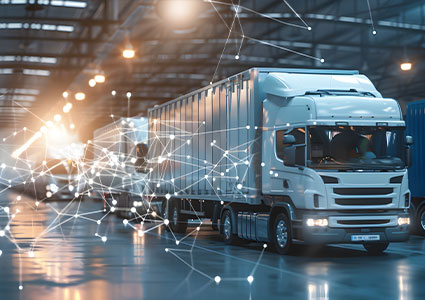Accelerate delivery operation in the age of e-commerce
The delivery industry has undergone a seismic shift in recent years, fueled by the explosive growth of e-commerce and evolving consumer expectations. This transformation has opened new avenues for innovation while amplifying several inherent challenges. Today, delivery companies are expected to provide faster, more reliable, and environmentally conscious services—all amidst an increasingly saturated market. So, what are the current complexities in the delivery landscape, what can resolve these challenges, and what emerging technologies are poised to redefine the space?
The current landscape of delivery
 We’re all tired of hearing about it, but the Covid-19 pandemic dramatically accelerated the growth of the delivery sector. This was as a result of face-to-face purchases being limited, leading to an increased reliance on e-commerce, which resulted in strong growth for the online sector. This surge in demand placed immense pressure on delivery companies to improve efficiency and reliability. However, high operational costs continue to plague the industry, squeezing profit margins and impacting pricing for consumers. Fierce competition among delivery services has resulted in a crowded market, making it harder for consumers to distinguish between providers.
We’re all tired of hearing about it, but the Covid-19 pandemic dramatically accelerated the growth of the delivery sector. This was as a result of face-to-face purchases being limited, leading to an increased reliance on e-commerce, which resulted in strong growth for the online sector. This surge in demand placed immense pressure on delivery companies to improve efficiency and reliability. However, high operational costs continue to plague the industry, squeezing profit margins and impacting pricing for consumers. Fierce competition among delivery services has resulted in a crowded market, making it harder for consumers to distinguish between providers.
Environmental concerns are also at the forefront of modern delivery operations. The carbon footprint associated with delivery vehicles continues to be a pressing issue, with transportation accounting for roughly 21 percent of global CO₂ emissions. Both companies and customers are now prioritizing eco-friendly practices, seeking solutions that mitigate environmental impact while maintaining service quality.
The drive for environmental practices can also be seen in the continued adoption of electric and hybrid vehicles. This is a political and environmental concern. By 2035, the UK and EU will prohibit the sale of new combustion cars. This means for businesses, there is a strong desire to adopt electric vehicles for delivery. However, what we are finding is that large enterprises have the funds and initiatives in place for electric vehicle adoption now. Although, while SMEs are keen to start using electric vehicles, they are slower to do so. The main reason for this is the range on electric vans and HGVs substantially lags behind their combustion engine counterparts. In addition, the large costs associated with adopting a completely new electric fleet, paired with the uncertain global economic landscape, are leading to a slower adoption of electric vehicles.
Demands for more efficient solutions
In response to these challenges, the market is growing for more efficient delivery solutions. Customer expectations have shifted drastically; they now demand not just speed but also transparency, convenience, and reliability in their delivery experiences. Companies that fail to meet these expectations risk falling behind in a hyper-competitive landscape.
One crucial area of focus is last-mile delivery, often cited as the most expensive and complex part of the delivery process. Urban congestion and high delivery costs pose significant hurdles, prompting companies to explore innovative solutions to streamline this final stage of delivery.
Making more deliveries in less time
Efficiency has always been at the heart of logistics. The current market demands that we push these boundaries further. The adoption of technology, ranging from advanced route optimization software like Geo2, to autonomous vehicles, can significantly enhance delivery speeds. Companies like Amazon and FedEx are already exploring drone technology and robotics to make same-day delivery a viable reality.
However, there has been a lot of talk and promise with the innovation of drone delivery, which offers the rapid and cost-effective transportation of small packages. Drones are particularly useful in remote or congested urban areas. They can bypass road traffic and deliver goods directly to consumers’ doorsteps. However, these urban areas are exactly where there are a lot of policy challenges and red tape. As a result, we are yet to see the widespread use of drones for delivery operations.
The integration of artificial intelligence into the delivery industry marks a transformative step towards achieving greater efficiency and speed. AI technology has the potential to revolutionize route planning, enabling delivery companies to optimize paths in real-time by analyzing traffic patterns, road conditions, and weather changes. This dynamic approach reduces delivery times and enhances the accuracy of estimated arrival times, improving customer satisfaction. 
AI-driven systems can also automate warehouse operations, streamline inventory management, and ensure the rapid dispatch of goods. By leveraging machine learning algorithms, companies can predict demand trends and preemptively allocate resources, minimizing delays and maximizing productivity. Geo2’s dynamic load building algorithms automatically assign consignments onto the back of vehicles, based on many factors, such as volumetrics, weight, distance, maximum driving hours of employees, and more. As AI continues to advance, its role in the delivery industry will be crucial in meeting the continuously growing demands of the global economy.
Using less fuel and tracking emissions
In the age of climate awareness, the delivery industry must take proactive steps towards sustainability. The carbon footprint of delivery vehicles is substantial, but with the right technological interventions, it can be minimized. As we have discussed before, electric and hybrid vehicles are becoming more prevalent, offering a cleaner alternative to traditional fuel-based vehicles. Furthermore, sophisticated tracking systems and transport management systems like Geo2, now allow companies to monitor emissions in real-time. They provide insights into how much CO₂ is being used, and how they can reduce their environmental impact. By optimizing delivery routes and consolidating shipments, not only is fuel consumption reduced, but operational costs are decreased too.
Conclusion
The delivery industry stands at a pivotal crossroads, where innovation and environmental responsibility intertwine. The challenges posed by rising consumer expectations, environmental pressures, and technological advancements require a proactive approach to drive meaningful change. By adopting AI-powered technologies, electric vehicles, advanced route optimization, and live tracking, the industry can not only meet the demands of today’s market but also pave the way for a sustainable and more efficient future.
For a list of the sources used in this article, please contact the editor.
Geo2
www.geo2.com
Geo2 is a cloud-based transport management system. It streamlines delivery processes, offering sophisticated route planning and optimization, along with real-time tracking and customer notifications. Businesses of all sizes can use Geo2 – from independent drivers to multinational enterprises. It elevates delivery performance, cuts operational costs and improves customer satisfaction. With Geo2, deliveries are faster, fuel consumption is minimized and every route is optimized for efficiency.
